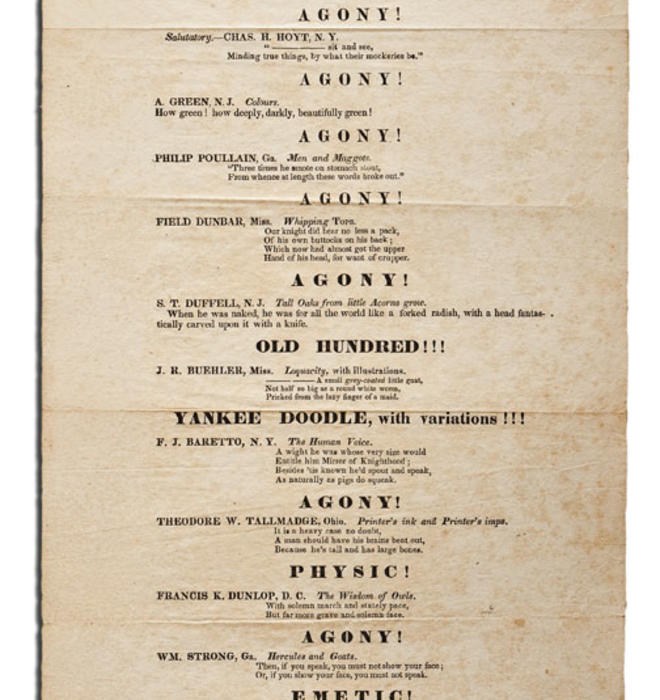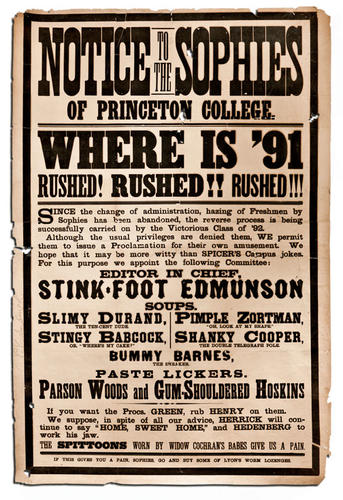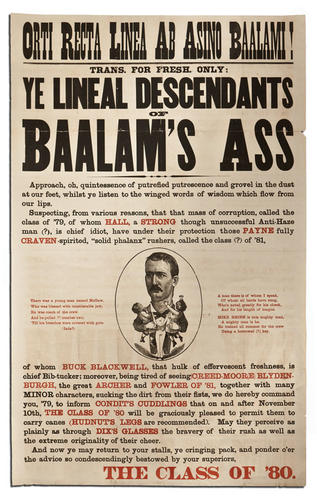
Oh, those zany sophomores
Historically, an awkward year inspired silliness and fun — and even the occasional riot
It’s not easy being a sophomore. Though no longer a neophyte, you aren’t yet endowed with the gravitas of the upperclassman. Even the word sophomore is vaguely insulting, being derived from the sophism, an argument that is clever, but fallacious. (The etymology “wise fool” is something of an urban legend.)
On campus back in 1878, a second-year student dared claim that the word sophomore means “more wise.” “I don’t see how this can be,” a freshman saucily replied, “as the sophomores seem to me the most foolish fellows in the college.”
Back then, interclass rivalries were heated, with sophomores especially worked up. The brimful class loyalty we feel mainly during Reunions was then a daily matter, since classes were segregated in lecture halls and dining commons. The posters shown here, part of a collection housed in Mudd Library, were published by students perennially eager to abuse other classes and celebrate their own.
In the 1840s, for example, sophomores lampooned graduating seniors by hosting spoof Sophomore Commencement ceremonies (as you see at right, spelling wasn’t taught until the junior year). They issued insulting broadsides and drank liquor, until horrified administrators shut the irreverent tradition down with threats of suspension.
Other posters were aimed at freshmen, or “yearlings.” Local printers were kept busy turning out swaggering “proclamations” that were stapled to barns all over town and even pasted on freight trains that rolled through Princeton Junction, carrying anti-freshman diatribes far and wide.
On every campus sidewalk, cocky sophomores enforced ironclad rules of freshman conduct: no orange-and-black attire, silk hats, pipe smoking, or playing marbles. They challenged freshmen to mock duels, then pretended to actually die, to yearlings’ horror. Sophomore contempt for freshmen found an outlet in ritualized battles called “rushes” or “sprees”: the nighttime Cannon Rush, in which sophomores painted the cannon green to mock the “verdancy” of the freshmen; the Gymnasium Rush, where sophomores blocked the front door to forestall freshman class elections. So furious were these contests, a hapless yearling died of a heart attack in 1915. Originally fought by moonlight in front of Witherspoon, freshman-sophomore Cane Spree survives today in a stylized version — and lately has incorporated a virtual, video-game contest.
At other times sophomores burst into freshmen’s rooms to haze the unfortunate. When a lad fought back in 1878, a melee ensued that saw sophomores shooting pistols out a window and led to a confused gunfight on Nassau Street. By the 1950s, hazing took the form of cutting class numbers into freshmen’s hair. When the administration banned the use of sharp scissors after several bad lacerations, resourceful sophomores switched to stencils and spray paint.
In decades past, Princeton’s unforgiving bicker system made many sophomores feel like outsiders, terrified of their coming fate in club elections. Sophomore fall was “the nadir of a Princeton student’s social career,” an undergraduate told The Daily Princetonian in 1965. Unbearable pressure, plus boredom, sometimes found a destructive outlet in sophomore rioting.
In 1963, 1,500 students ransacked campus and town, collapsing the fence at Prospect House and heaping up a bonfire of benches in Palmer Square. Of the 14 arrested, most were sophomores, including the vice president of the class. An outraged president Robert Goheen ’40 *48 called it “a shocking display of individual and collective hooliganism.”
The many sophomores rooming in Holder Hall made that dormitory infamous for riotous eruptions. In 1972, “Holder hooligans” (proudly adopting Goheen’s term) trashed the courtyard with mud-sliding and bonfires, flooded a room with a hose, and even kidnapped a Dartmouth cheerleader from a football game. A “Snow Day” riot at Holder two years earlier presaged that infamous sophomore ritual, the Nude Olympics.
Such organized mayhem seems to be a thing of the past now. “I can’t say I’ve heard of the traditional riot,” says current sophomore class president Zach Beecher. “The administration does its damnedest to see these things don’t happen.” Also gone are most of the customary sophomore pranks.
Much has changed at Princeton, but sophomore year remains a difficult time for many. The workload inexorably builds; high hopes sometimes give way to the malaise called “sophomore slump”; the future is uncertain. “There are two big question marks,” says Beecher — choosing a major and deciding whether to join an eating club. “It can be a challenging year.”
Generation after generation, sophomores try on new identities during this time Beecher calls “exciting for all its potential” — identities that sometimes seem preposterous in retrospect. There have been more than a few sophomores like Tanaduke Wylie in This Side of Paradise, who went around making pronouncements such as, “The earth swirls down through the ominous moons of preconsidered generations!”
Yes, sophomores sometimes get lost in their own sophistries. Nationwide, university administrators are paying increased attention to the unique problems and challenges of sophomores after many years of worrying mostly about freshmen, says Thomas Dunne, Princeton’s associate dean of undergraduate students. “It’s a pivotal year at Princeton, one with many crucial decisions,” he notes.
His office recently instituted the Halftime Retreat, a three-day, off-campus experience just for sophomores. Forty attended this year, engaging in reflection and journal writing, trying to understand themselves better and decide which directions to take for their remaining two years at Old Nassau — years that often get brighter once the sophomoric phase is done.
W. Barksdale Maynard ’88 is the author of Woodrow Wilson: Princeton to the Presidency and a book on the history of Princeton’s architecture, coming in 2012.










No responses yet